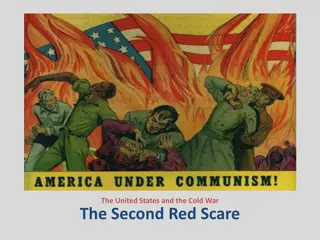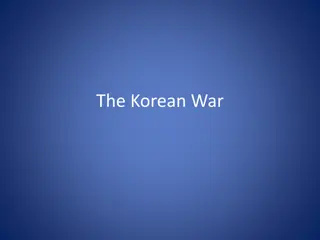Overview of the Korean War: Background, Discussion, and Outcome
This presentation delves into the background of the Korean War, highlighting the historical context from the Korean Peninsula's division after World War II to the outbreak of the conflict in 1950. It discusses the involvement of North and South Korea, as well as key players like the United States, the USSR, and China. The presentation also covers the military actions, UN responses, and the eventual outcome of the war. Veteran experiences are shared, offering a personal perspective on the war's effects.
Download Presentation

Please find below an Image/Link to download the presentation.
The content on the website is provided AS IS for your information and personal use only. It may not be sold, licensed, or shared on other websites without obtaining consent from the author.If you encounter any issues during the download, it is possible that the publisher has removed the file from their server.
You are allowed to download the files provided on this website for personal or commercial use, subject to the condition that they are used lawfully. All files are the property of their respective owners.
The content on the website is provided AS IS for your information and personal use only. It may not be sold, licensed, or shared on other websites without obtaining consent from the author.
E N D
Presentation Transcript
Tell America Introduction Purpose of Today s Presentation Background on the Korean War Discussion of The War Outcome of the War - In Perspective Veteran Experiences
Tell America Background of the Korean War The Neighbors (whales) Japan China Russia / USSR Korea (the shrimp) Hermit Kingdom Ceded to Japan 1905 Japanese Annexation 1910-1945 Part of the Japanese Empire Brutal Colonial Experience Workers, Troops & Natural Resources for Japan
Tell America Background of the Korean War (cont.) End of World War II Aug 15, 1945 Allied Occupation of Japanese areas Yalta Agreement was basis Soviets Northern half of Korea American Southern half of Korea Soviets and Americans withdraw 1948 Democratic People's Republic of Korea Republic of Korea (ROK) South Korea Border Skirmishes, Rice Raids and political instability from 1945 leading up to 1950 Communist North Korea Democratic South Korea
Tell America Communist North Korea Background of the Korean War (cont.) Korea In the Cold War USSR puts Kim Il-Sung in power in NK Stalin thinks ROK is outside US sphere Communists Win Civil War in China 49 Chinese Soviet Relations Americans want out of South Korea Removes Combat Troops in 1949 Korean Military Advisory Group - KMAG 500 advisors; limited weapons no tanks, artillery or aircraft South Korean Constabulary protects borders Border Skirmishes, Rice Raids and political instability from 1945 leading up to 1950 Democratic South Korea
Tell America Outbreak of Korean War June 25, 1950 North Korean surprise attack Russian-made T-34 Tanks, Artillery Swept south quickly; captures Seoul Birth of the ROK Army in war American supports South Korea Air, Naval and Ground forces Task Force Smith July 1950 ROK Army & Americans withdraw Fighting retreat to Pusan Perimeter NKPA stretched thin; hard fighting US and UK troops arrive
Tell America United Nations Responses June 25, 1950 UN Resolution 82: determined that this action constituted a breach of the peace and called for the immediate cessation of hostilities, with the North Koreans withdrawing. June 27, 1950 UN Resolution 83: observed North Korea's failure to comply with Security Council Resolution 82 and that urgent military measures were required to restore international peace and security. July 7, 1950 UN Resolution 84: recommended that the members of the United Nations furnish such assistance to the Republic of Korea as may be necessary to repel the attack and restore peace and security to the area. The Soviet Union was absent and did not vote; Communist China was not a UN member nation and had no standing
Tell America Inchon and Breakout Sept. 15, 1950 US troops land at Inchon NKPA stretched thin and beaten US, UK & ROK troops surge north from Pusan Perimeter NKPA collapses and retreats Seoul liberated September 1950 ROK Army crossed 38th Parallel Oct. 1, 1950; US/UN forces Oct. 7, 1950 Communist Chinese send indirect messages of concern over the Korea question. The Peoples Volunteer Army formed from Chinese Communist Forces (CCF) 300,000 CCF troops march undetected into North Korea, beginning in Oct. 1950 US, UN and ROK troops advance to the Yalu River
Tell America Chinese Intervention Nov. 3, 1950 North Korean Army beaten US/UN/ROK forces near China CCF masses 300,000 troops and attacks in very bitter winter weather USMC / Army at Chosin Resevoir a fighting retreat thru Dec. 1950 UN Forces retreat south; many losses US 8th Army CG Walker dies; Gen. Ridgeway takes over Seoul evacuated by UN forces CCF & NKPA occupy Gen Ridgeway revitalizes US & UN Forces CCF and NKPA unable to push forward supplies, ammunition and manpower limited
Tell America War of Attrition the Long Fight CCF and NKPA advance was stopped UN Forces launch Operations Ripper and Killer focus on destroying CCF / NKPA forces Terrain and weather are harsh Seoul liberated March 14-15 by ROK 1st Division and US 3rd Infantry Division April 3, 1951, UN forces cross 38th Parallel; MacArthur relieved, April 11; Ridgeway appointed UN Commander UN Forces grind north, taking more terrain July 10, 1951 Armistice Talks Begin at Kaesong, a North Korean-controlled city
Tell America War of Attrition King of the Hill Fighting continues until June 13, 1951 UN forces hold, pending Armistice Talks skirmishes and patrol actions CCF and NKPA use the Armistice for propaganda and to buy time to rearm and prepare Communists quit talks in August 1951 over an insult UN Operations the Hill Fights begin Heartbreak Ridge, the Punchbowl, Capitol Hill, The Hook, White Horse Mountain , put pressure on CCF leaders Operation Summit a US Marine infantry company transported by helicopters, captures a hilltop, establishing a combat outpost 1st use of helicopters for combat deployment - Sept 13, 1951 Armistice Talks and Fighting grind on through 1953, with the talks at Panmunjon, between the forces.
Tell America War of Attrition Summer of 1953 CCF and UN Forces continue the King of the Hill fighting. US and UN forces limit combat operations, balancing losses against gains. Armistice is stalled due to Prisoner of War Question and Communist demands that all POWs are returned. US/UN will not forcibly repatriate POWs who do not want to go to Communist China or North Korea. 7th Infantry Division trenches, July 1953 (National Archives) On June 13, 1953, Communist agree POWs terms voluntary repatriation under control of neutral powers CCF attacks to put pressure on UN and ROK forces Outposts Tom, Dick and Harry break CCF attacks; ROK Army punished at Kumwah July 27, 1953 Armistice signed by CCF, NK, US & UN representatives ROK refuses Fighting ends and a Demilitarized Zone (DMZ) is created between the armies. Repatriation screening of Communist POWs. 1952 (National Archives)
Tell America Interesting aspects of the Korean War A limited war in the context of the Cold War First war where American troops were racially integrated First Jet War involving air combat between jet fighters First war where Helicopters were used in operations Major advancements in Military Medicine MASH Mobile Army Surgical Hospital
Tell America The Aftermath The War ended with North Korea Communist and South Korea a democracy Both countries suffered horrible costs millions dead, homes, factories and infrastructure destroyed or damaged. The UN successfully defended a member state and avoided a wider war Cost billions of dollars, yet saved a people US: 36,700 dead; 97,000 wounded; 8,176 MIA, 7,245 POW ROK: 137,899 dead, 450,000 wounded, 32,838 MIA or POW UN Forces: 3,407 dead; 12,705 wounded; 1,796 MIA; 1,376 POW NKPA: 215,000 dead; 303,000 wounded; 120,000 MIA or POW CCF: 183,108 dead; 383,000 wounded; 25,621 MIA; 21,400 POW
Tell America The Aftermath The War ended with North Korea Communist and South Korea a democracy Both countries suffered horrible costs millions dead, homes, factories and infrastructure destroyed or damaged. The UN successfully defended a member state and avoided a wider war Cost billions of dollars, yet saved a people US: 36,700 dead; 97,000 wounded; 8,176 MIA, 7,245 POW ROK: 137,899 dead, 450,000 wounded, 32,838 MIA or POW UN Forces: 3,407 dead; 12,705 wounded; 1,796 MIA; 1,376 POW NKPA: 215,000 dead; 303,000 wounded; 120,000 MIA or POW CCF: 183,108 dead; 383,000 wounded; 25,621 MIA; 21,400 POW
Tell America One Veteran s Perspective Where and When I served What I carried and Wore What I remember the best What I think of Korea today? What I hope comes out of my sharing my Korean War experience.































